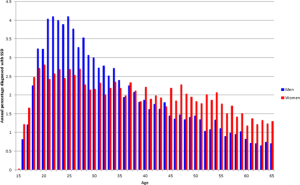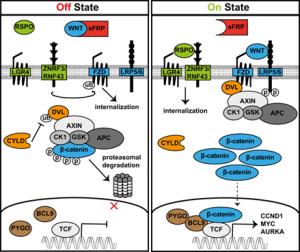Artstract by Dhruvika Patel
What is Schizophrenia?
Before looking at pathway dysfunction, it’s important to understand what exactly schizophrenia is and its implications. Schizophrenia is a mental condition that can be triggered from not one specific pinpoint of dysregulation, but rather a variety of different genetical, psychological, and environmental factors. This makes preventative measures difficult to take. While it affects less than one percent of the U.S. population, the effects are far from easy to live with. But what exactly does having schizophrenia imply? It normally involves delusions, hallucinations, disorganized speech, grossly disorganized behavior, and withdrawal from social activities. Two or more of these should be seen for a significant amount of time and cannot be due to substance abuse to diagnose an individual with schizophrenia.
Schizophrenia is typically diagnosed in people in their late teens to early thirties, so it is not a condition that necessarily comes with old age. Males are more likely to be

diagnosed earlier in their lives than females are; however, this is a condition that is often difficult to recognize in the early phases. To recognize it earlier, symptoms to look for with thinking may be problems with reasoning, bizarre ideas or speech, or confusing dreams or television for reality. Early behavioral problems could include withdrawal from family and friends, trouble sleeping, lack of motivation, not meeting daily expectations, or violent or aggressive behaviors. Emotionally, they would be irritable or depressed, have a lack of emotion, have strange anxieties and fears, or just be very suspicious of others. The range of earlier symptoms could be difficult to tie directly to schizophrenia and not anything else, but as they age, more typical signs and symptoms (ie. delusions, etc.) will appear.
Wnt Signaling and Schizophrenia
Patients with schizophrenia have a lower cognitive ability which may be a result of wnt signaling pathway development or rather lack of. The beta-catenin functioning properly in the wnt-signaling pathway is vital in synaptic plasticity of the neurons in human brains. Normally, GSK will be inhibited in the wnt-signaling pathway, which will allow beta-catenin to get to the nucleus. If GSK is not inhibited, it will tag the beta-catenin to go to the proteosome instead to be destroyed. Beta-catenin’s interactions in the nucleus is important for cell proliferation, differentiation, and apoptosis. Beta-catenin is important for the transduction of the signal to the nucleus and once it reaches the nucleus, it can transcribe the wnt-related genes that control cell fate in cells and tissues.
BCL9 and Beta-Catenin’s success
BCL9, B-cell lymphoma 9, is often not emphasized in the wnt pathway, but it does have an important role in Beta-catenin’s proper functioning. What is BCL9 and where does it come from? B-cell lymphoma is a large protein encoded by the BCL9 gene expressed in all tissues of the body. In the wnt-pathway it works with another protein, PYGO, to tether Beta-catenin to TCF/LEF. This tethering allows for efficient T-cell factor mediated transcription in the wnt signaling pathway; without it, the beta-catenin may not properly bind to the transcription factors to transcribe the necessary genes. Think of BCL9 acting like cupid to bring the transcription factors and beta-catenin together.

Conclusion
Schizophrenia is not necessarily an easy condition to diagnose until the symptoms become more obvious. It makes one wonder possibilities for what may be causing this. One pathway that alterations can cause problems with is the wnt pathway. The wnt signaling pathway is composed of such a variety of components that affect its proper functioning. The final goal is for beta-catenin to transcribe the appropriate genes, and dysfunction here can lead to a multitude of mental disorders including Schizophrenia. One of the many important components of the success of this pathway includes BCL9, with its function vital in tethering the beta-catenin to the transcription factors.
Citations:
- https://www.nature.com/articles/s41537-020-0102-z
- https://www.nature.com/articles/s41375-019-0404-1
